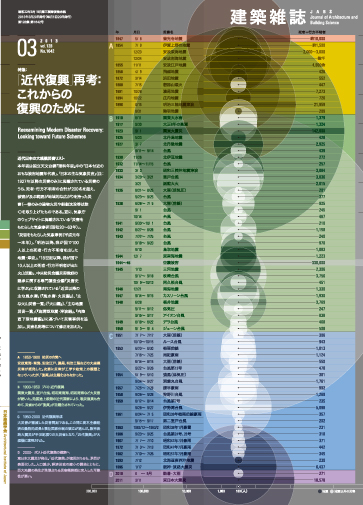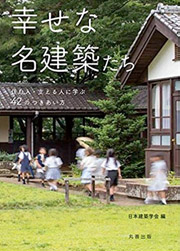本文PDFの閲覧につきましては、こちらでご確認ください。

2013-3月号 MARCH
特集= 「近代復興」再考
─これからの復興のために
Reexamining Modern Disaster Recovery─ Looking toward Future Schemes
特集前言 20世紀後半型レジームを超えて
本誌ではこれまで東日本大震災の投げかける諸問題について多角的に特集を組んできた。
まず、2012年1月号で3.11前夜までの東北の歴史的文化的な「地図」を描いた後、3.11が建築の学・術に与えているインパクトを「視点・分野」別に把握・議論した。年を跨ぐ2012年12月号、2013年1月号では津波被災地と福島原発被災地の「現場」の実態と課題を掘り下げ、2月号では3.11から南海トラフへの問題の「波及」を扱った。そして、震災2周年にあたる本号は「体制」を問う試みである。本号をもって、私たちの編集体制としては東日本大震災を直接に扱う特集にいちおうの区切りをつける。
さて、阪神・淡路大震災や東日本大震災を含む、近年の災害復興の枠組みを、本特集では「近代復興」という造語で呼ぶことにした。いくぶん乱暴かもしれないが、議論の土俵をつくるための作業仮説である。大ざっぱに言えば、「近代復興」は20世紀前半の災害復興の経験をベースとしているが、20世紀後半の戦後日本社会の刻印が深い。そして、20世紀末にはすでに限界・矛盾が露呈したが、現在も大きな書き換えのないまま適用され、難問がより顕著に浮き上がっている。
表紙で示したように、20世紀後半は大災害が相対的に少ない時期だった。19世紀後半も20世紀前半も大規模な災害が頻発しており、20世紀末以降は再び震災頻発期に突入しているから、日本の「戦後」はエアポケットのような特殊な時期だった。その間に、企業中心の資本主義経済を爆発的に成長させ、その果実を再分配する仕組み(福祉国家)を日本は築いてきた。「近代復興」もまた、この時期に形成された社会システムの一部であろう。大災害が起こると、基盤整備を優先するために被災地をいったん凍結し、被災地から離れた場所に仮設住宅を公的に供給するなど、発災から復興宣言までのフェーズを互いに干渉が生じないように切り分けつつ、マッシブな建設が推進される。事業の主体は自治体だが、全体スキームは中央政府・官僚が主導し、その間を省庁縦割りの補助金が媒介している。これが経済成長を前提として組み立てられてきた体制である以上、成熟経済へと局面が変わればさまざまな矛盾が噴出するのは当然であった。
むろん、私たちはこの体制を全否定してもはじまらないし、東日本大震災の現場ではこの体制のなかで可能性を見いだす苦闘が積み重ねられている。しかし、私たちは同時にこの大きな枠組み自体を歴史的に相対化しつつ、新しい枠組みの構築に向けた議論を臆せず社会化せねばならないだろう。
本特集の冒頭には、編集部による造語「近代復興」の説明に続けて、世界の災害復興スキームの代表的な事例と日本のそれとを比較するダイヤグラム、さらに日本の「近代復興」の形成史年表(田中傑氏作成)を掲載した。これらが序論的な資料編にあたる。
続く第1部は歴史認識編である。吉川仁氏には災害対策法制、中野茂夫氏には基盤整備の標準化(レディ・メイド化)、そして、越山健治氏には被災者支援のそれぞれについて歴史的な経緯を解説いただいた。これら論考により「近代復興」の歴史性・特殊性が明確化するだろう。
第2部では、二つの角度から「近代復興」を批判的に総括しつつ、今後の展望を素描する。まず、復興の政策体系・ガバナンスを焦点とする座談会には、佐々木晶二・増田寛也・蓑原敬の三氏をお招きした。一方、近年の災害復興における「民」の役割をとらえようとするのが津久井進・村井純両氏の対談である。これら二つの討論は、互いに論点をオバーラップさせながら、私たちに「近代復興」再考の論点と「ポスト近代復興」の可能性を示唆している。
最後に「ポスト近代復興」の展望に向けて多様な立場や論点を示そうと考えたのが第3部である。五十嵐敬喜・伊藤滋・小熊英二・越澤明・寺島英弥・広原盛明・紅邑晶子・松本三和夫・室崎益輝・藻谷浩介の諸氏に、本号のテーマをぶつけ、自由に持論を展開していただいた。
会誌編集委員会
本号編集担当:中島直人(慶應義塾大学)・牧紀男(京都大学防災研究所)・村尾修(筑波大学)
[目次]
| 000 | 連載 再建への意志:図面のなかの都市復興 1902年香港植民地の都市建築デザイン案─もっと光と空気を!/泉田英雄 |
| 002 | 連載 東日本大震災|連続ルポ1|動き出す被災地 いわき豊間地区─協議会の地域主体の復興まちづくりへの取組み/佐藤俊一 |
| 004 | 連載 東日本大震災|連続ルポ2|仮すまいの姿 九州北部豪雨被災地における熊本県阿蘇市住民の仮住まいの姿─木造応急仮設住宅整備の過程/桂英昭 |
| 006 | 特別対談 工学が扱う世界に境界線はない─土木・建築両学会長の対話/小野武彦 × 和田章 |
特集 「近代復興」再考:これからの復興のために
| 010 | 特集前言 20世紀後半型レジームを超えて |
序 「近代復興」とは何か
| 012 | 「近代復興」とは何か/会誌編集委員会 |
| 013 | 各国の復興組織/会誌編集委員会 |
| 014 | 「近代復興」成立史年表/田中傑 |
第1部 「近代復興」の成立
| 018 | 被災後対応の歴史に学ぶ─災害対策の新しい枠組みに向けて/吉川仁 |
| 022 | 基盤整備にまつわる標準化の経緯─オーダー・メイドからレディ・メイドへ/中野茂夫 |
| 026 | 被災者の住宅再建支援方策の歴史的展開/越山健治 |
第2部 「近代復興」の総括と課題
| 030 | 座談会 復興における政府の役割、地方の役割/佐々木晶二 × 増田寛也 × 蓑原敬 |
| 036 | 対談 復興における民の力/津久井進 × 村井純 |
第3部 「ポスト近代復興」の展望
| 042 | 近代の復興を超える─現代的生存権と総有論/五十嵐敬喜 |
| 043 | 老朽建築物更新に関する公的介入について/伊藤滋 |
| 043 | 現代に不適合な復興レジーム/小熊英二 |
| 044 | 住まい・雇用を見据えた現実的な復興像と復興施策を/越澤明 |
| 045 | 復興の主体は誰か? 被災地に生まれた『自助』の支援/寺島英弥 |
| 045 | 近代復興は「土建ムラ」と双生児だった(パロディー)/広原盛明 |
| 046 | 被災地が取り組む復興の歩みは、地方都市の地域課題解決モデル/紅邑晶子 |
| 047 | 構造災をこえて/松本三和夫 |
| 048 | 問われているのは、計画論と専門家/室崎益輝 |
| 048 | 人口成熟を見越した復興/藻谷浩介 |
| 051 | 編集後記 中島直人 + 牧紀男 + 村尾修 |
| 051 | 次号予告 2013年4月号|特集:2020年省エネ義務化:建築はそのとき |
| 052 | 特集を読んで 2013年1月号|特集:福島と建築学 建築学的福島問題の長い始まり/石川初 「ふるさと」の根底が問われている/鳴海邦碩 |
| 053 | 連載 建築の争点 耐震偽装事件後̶構造設計の何が変わったか/木原碩美 |
| 054 | 連載 ケンチク脳の育て方 群雄割拠する建築学生団体/松田達 |
| 055 | 連載 ケンチク脳の活かし方 複雑化する広告コミュニケーションを設計する/阿部光史 |
| 056 | 連載 地域いろいろ・多様な日本 都市農地の混在する市街地/生田京子 |
Preface to the Special Issue: Overcoming the Late-Twentieth-Century Regime
JABS has diversely made up features about all sorts of issues that the Great East Japan Earthquake presented until now.
First, after drawing historical and cultural maps of Tohoku on the night before 3.11 in the January 2012 issue, we grasped and argued about the impact that 3.11 had on architectural learning and techniques, viewpoints and fields considered separately. In the December 2012 and January 2013 issues we delved into the on-site realities and problems in the tsunami-devastated areas and the Fukushima nuclear-devastated area. And in the February issue we dealt with repercussions of problems, from 3.11 to the Nankai Trough. This issue, then, on the second anniversary of the great earthquake, is a trial to question the system. And on this occasion, we, as the editorial board, will, for the present, bring to an end the feature that deals directly with the Great East Japan Earthquake.
Now, we decided to call the framework of recent disaster recoveries, including from the Hanshin-Awaji Earthquake and the Great East Japan Earthquake, modern disaster recovery, which is a coinage in this feature. It may be a little rough, but it's a working hypothesis to create the grounds of an argument. Generally speaking, modern disaster recovery is based on the experiences in the first half of the 20th century, but actually it is deeply marked by the post-war Japanese society in the second half of the 20th century. And although limitations and contradictions had already appeared at the end of the 20th century, they are still applicable without much change - difficult problems are surfacing more obviously.
As the cover shows, the second half of the 20th century was a time of relatively few big disasters. Because big disasters occurred frequently either in the second half of the 19th century or the first half of the 20th century, and after the end of the 20th century Japan again plunged into a time of frequent disasters, "Japan post-war" was a period as special as if it were an air pocket. In that period, Japan's capitalistic business core boomed and the country built a machine (the welfare state) to redistribute the fruits. Modern disaster recovery also would be a part of the social system formed in that period. When a big disaster occurs, the disaster areas are once frozen and priority goes to infrastructural development; meanwhile, the public supply of temporary houses away from disaster areas and other such measures are cut into phases, from the beginning of the disaster until recovery is declared, to avoid phases interfering with each other; and massive construction is promoted. Although the projects are implemented by local municipalities, the national government and bureaucracy have the initiative in total schemes; thus, sectionalized subsidies from ministries and agencies mediate between the local and central groups. But that system was formed on the premises of a growing economy, and as the economy declines various contradictions naturally erupted.
Of course, it is no use to negate this system totally, and, at the site of the Great East Japan Earthquake, agonies have mounted in trying to find the possibilities in the system. But at the same time, while we historically relativize this big framework itself, we would have to boldly socialize the argument in structuring any new framework.
At the opening of this feature, following the explanation of the editorial board's coinage, modern disaster recovery, we inserted a diagram that compares typical disaster-recovery schemes in the world with those in Japan, plus a chronological table showing the formation of Japan's modern disaster recovery (by Masaru Tanaka). These all appear in the introductory material.
Part 1 then focuses on historic knowledge: Jin Yoshikawa explains disaster-countermeasure legislation; Shigeo Nakano, the standardization of infrastructure development (from order-made to ready-made); and Kenji Koshiyama, the historical course of varied support for sufferers. These deliberations will clarify the historicalness and particularity of modern disaster recovery.
In part 2 we sketch the outlook hereafter, critically summarizing modern disaster recovery from two angles. First, for the round table that focuses on the policy system and governance of recovery, we invited Shoji Sasaki, Hiroya Masuda, and Kei Minohara. In contrast, the talk by Susumu Tsukui and Jun Murai tries to get at the people's role in recent disaster recoveries. These two discussions, while revealing contentions that overlap each other, suggest the disputed points in any reconsideration of modern disaster recovery and the possibility of postmodern disaster recovery.
At the end, part 3 tries to indicate various situations and disputed points for a view of postmodern disaster recovery. We threw out this feature's theme and asked the following people to freely develop opinions: Takayoshi Igarashi, Shigeru Ito, Eiji Oguma, Akira Koshizawa, Hideya Terashima, Moriaki Hirohara, Akiko Benimura, Miwao Matsumoto, Yoshiteru Murosaki, and Kosuke Motani.
Editorial Board
This issue has been edited by Naoto Nakajima (Keio University), Norio Maki (Disaster Prevention Research Institute Kyoto University), and Osamu Murao (University of Tsukuba).
[Contents]
| 000 | [Series] The Resolve to Rebuilding: City Reconstruction in Blueprint The City Architecture Design Proposal for Hong Kong Colony in 1902 ─More Light and Air! / Hideo Izumida |
| 002 | [Series] Great East Japan Earthquake Serial Report 1 Devastated Areas Have Just Started to Stir Toyoma District in Iwaki ─Local Independent Efforts for Recovery Town Improvement by Council / Shunichi Satoh |
| 004 | [Series] Great East Japan Earthquake Serial Report 2 Life in Temporary Housing The Shape of Temporary Living among Kumamoto's Aso People in North Kyushu' s Rain-Devastated Area ─The Maintenance Process in Emergency Wooden Temporary-Housing / Hideaki Katsura |
| 006 | [Special Dialogue] Any Border Should not Be in the Engineering World ─Chairmen dialogues of JSCE and AIJ / Takehiko Ono × Akira Wada |
Special Feature
Reexamining Modern Disaster Recovery: Looking toward Future Schemes
| 010 | [Preface to the Special Issue] Overcoming the Late-Twentieth-Century Regime |
Preface What Is Modern Disaster Recovery?
| 012 | What Is Modern Disaster Recovery? / Editorial Board |
| 013 | Recovery Management System in the World / Editorial Board |
| 014 | Chronological Table of the Modern Disaster Recovery System's Formation / Masaru Tanaka |
Part1 The Birth of Modern Disaster Recovery
| 018 | Learning from the History of Post-Disaster Measures ─Toward a New Framework of Disaster Countermeasures / Jin Yoshikawa |
| 022 | The Standardization of Infrastructure Development ─from Order Made to Ready Made / Shigeo Nakano |
| 026 | The Historical Evolution of the Public Assistant System for Damaged Dwelling Recovery / Kenji Koshiyama |
Part2 Summary and Issues of Modern Disaster Recovery
| 030 | [Discussion] The Roles of Government and Localities in Recovery / Shoji Sasaki × Hiroya Masuda × Kei Minohara |
| 036 | [Dialogue] People Power in Recovery / Susumu Tsukui × Jun Murai |
Part3 The Outlook for Post-Modern Disaster Recovery
| 042 | Up-to-Date Survival Rights and Entire-Ownership Theory That Transcend Modern Recovery / Takayoshi Igarashi |
| 043 | About Public Intervention for the Renovation of Decrepit Buildings / Shigeru Ito |
| 043 | The Reconstruction Regime in Japan is Out of Date / Eiji Oguma |
| 044 | Calling for a Practical Recovery Image and Recovery Policy That Focus on Housing and Employment / Akira Koshizawa |
| 045 | Who Is the Core of Recovery? ─ The Self-Help Support Born in Devastated Areas / Hideya Terashima |
| 045 | Modern Recovery Was a Twin to a Contractors' Town (Parody) / Moriaki Hirohara |
| 046 | The Steps by Which Devastated Areas Work toward Recovery Are Solution Models for Local Issues in Regional Cities / Akiko Benimura |
| 047 | Overcoming Structural Disaster / Miwao Matsumoto |
| 048 | What' s Questioned Are Planning Theory and Experts / Yoshiteru Murosaki |
| 048 | Recovery That Anticipates Population Maturity / Kosuke Motani |
| 051 | [Editor's Postscripts] Naoto Nakajima + Norio Maki + Osamu Murao |
| 051 | [Previews of Coming Issues] 2013, April|Energy Conservation Obligatory in 2020: Implications for Architecture Then? |
| 052 | [Reviews of Previous Issue] 2013, January|Fukushima and Architecture A Long Start to Fukushima Architectural Issues / Hajime Ishikawa Hometown Roots Are Being Questioned / Kunihiko Narumi |
| 053 | [Series] Issues in Architecture What Has Changed in Structural Design After the Case of Falsified Seismic Strength? / Hiromi Kihara |
| 054 | [Series] Cultivating Versatile Architects Rivaling Architecture-Student Associations / Tatsu Matsuda |
| 055 | [Series] Architects Branch Out Designing Increasingly Complicated Ad-Communication / Mitsushi Abe |
| 056 | [Series] Local Identities: Diverse Japan Built-Up Areas that Mingle with Urban Farmland / Kyoko Ikuta |





 『幸せな名建築たち 住む人・支える人に学ぶ42のつきあい方』
『幸せな名建築たち 住む人・支える人に学ぶ42のつきあい方』





